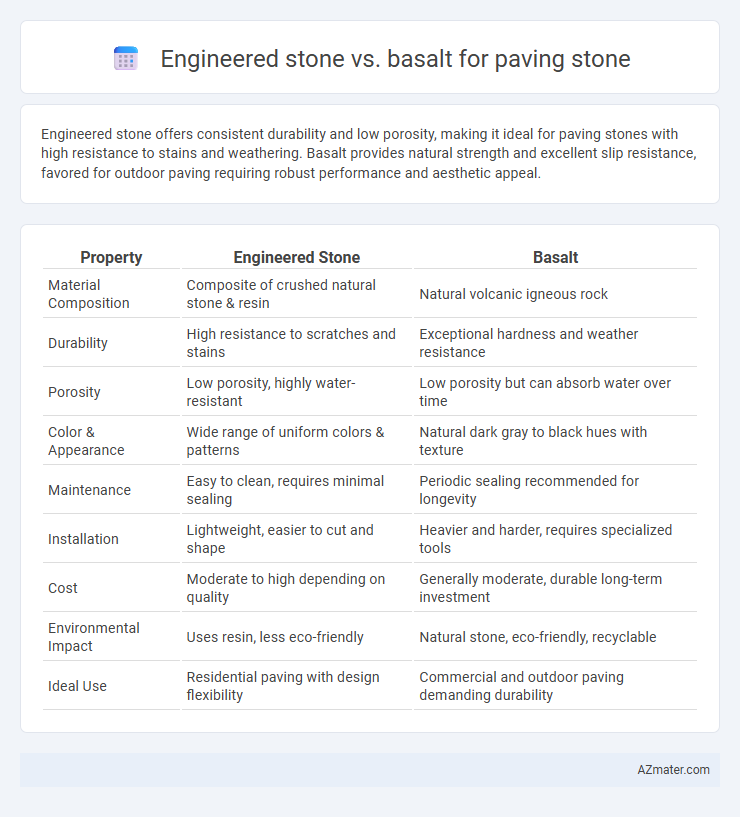Engineered stone offers consistent durability and low porosity, making it ideal for paving stones with high resistance to stains and weathering. Basalt provides natural strength and excellent slip resistance, favored for outdoor paving requiring robust performance and aesthetic appeal.
Table of Comparison
| Property | Engineered Stone | Basalt |
|---|---|---|
| Material Composition | Composite of crushed natural stone & resin | Natural volcanic igneous rock |
| Durability | High resistance to scratches and stains | Exceptional hardness and weather resistance |
| Porosity | Low porosity, highly water-resistant | Low porosity but can absorb water over time |
| Color & Appearance | Wide range of uniform colors & patterns | Natural dark gray to black hues with texture |
| Maintenance | Easy to clean, requires minimal sealing | Periodic sealing recommended for longevity |
| Installation | Lightweight, easier to cut and shape | Heavier and harder, requires specialized tools |
| Cost | Moderate to high depending on quality | Generally moderate, durable long-term investment |
| Environmental Impact | Uses resin, less eco-friendly | Natural stone, eco-friendly, recyclable |
| Ideal Use | Residential paving with design flexibility | Commercial and outdoor paving demanding durability |
Introduction to Engineered Stone and Basalt
Engineered stone, composed of crushed quartz mixed with resins and pigments, offers exceptional durability, uniformity, and a wide range of colors ideal for paving stones. Basalt, a natural volcanic rock, is prized for its strength, density, and resistance to wear and weather, making it a long-lasting option for outdoor paving. Both materials provide robust solutions, with engineered stone delivering design versatility and basalt excelling in natural resilience.
Composition and Manufacturing Process
Engineered stone is made primarily from crushed quartz mixed with resin and pigments, offering consistent color and high durability through a controlled manufacturing process involving compression and curing. Basalt paving stone is a natural igneous rock formed from cooled lava, composed mainly of pyroxene and plagioclase minerals, quarried and cut to size without additional processing. The manufacturing of engineered stone allows for uniformity and customization, while basalt maintains unique natural textures and inherent strength due to its volcanic origin.
Appearance and Aesthetic Versatility
Engineered stone offers a wide range of colors and patterns that mimic natural stone while providing consistent texture, making it highly versatile for modern design aesthetics. Basalt features a uniform dark gray to black color with a natural matte finish that adds a sleek, minimalist look ideal for contemporary and industrial styles. Both materials enhance outdoor spaces, but engineered stone's customizable appearance allows for more tailored, visually dynamic paving options.
Durability and Strength Comparison
Engineered stone offers high durability and consistent strength due to its composite materials, making it resistant to cracking and wear for heavy foot traffic areas. Basalt, a natural volcanic rock, exhibits exceptional compressive strength and weather resistance, ideal for outdoor paving exposed to harsh environmental conditions. Both materials provide robust performance, but basalt's natural density generally surpasses engineered stone in long-term structural integrity.
Weather Resistance and Longevity
Engineered stone offers excellent weather resistance due to its low porosity and uniform composition, preventing water absorption and reducing freeze-thaw damage, whereas basalt, a natural volcanic rock, exhibits superior durability and inherent resistance to extreme weather conditions, including UV exposure and temperature fluctuations. Basalt's natural mineral density contributes to its exceptional longevity, often surpassing engineered stone in withstanding heavy traffic and erosion over time. While both materials perform well for paving stone applications, basalt's natural resilience typically results in a longer lifespan with minimal maintenance.
Installation Methods and Ease
Engineered stone paving offers precision-cut slabs, enabling straightforward installation with adhesive bonding and minimal joint spacing, making it suitable for both DIY and professional applications. Basalt pavers require more labor-intensive processes such as dry laying on a compacted base or mortar bedding, demanding skilled handling to ensure proper leveling and joint alignment. The uniformity of engineered stone simplifies alignment and reduces installation time, while basalt's natural variability provides unique aesthetics at the cost of more complex fitting.
Maintenance Requirements
Engineered stone requires minimal maintenance due to its non-porous surface, resisting stains, scratches, and weathering, making it ideal for high-traffic paving applications. Basalt, a natural volcanic rock, demands periodic sealing to prevent water absorption and surface degradation, especially in freeze-thaw climates. Regular cleaning is essential for both materials to maintain aesthetic appeal, but engineered stone's durability significantly reduces long-term upkeep costs compared to basalt.
Environmental Impact and Sustainability
Engineered stone, composed primarily of crushed quartz and resins, often involves energy-intensive manufacturing processes and synthetic materials that may not be biodegradable. Basalt, a natural volcanic rock, offers a more sustainable option due to its abundance, durability, and minimal processing requirements, resulting in a lower carbon footprint. Using basalt for paving stones also supports environmental conservation by reducing reliance on synthetic resins and minimizing landfill waste.
Cost Analysis: Engineered Stone vs Basalt
Engineered stone typically costs between $50 to $100 per square foot, making it a flexible option for budget-conscious projects, while basalt ranges from $30 to $80 per square foot but may incur higher installation expenses due to its density and weight. The longevity and low maintenance of basalt can offset initial costs, although engineered stone offers faster installation and design versatility that can reduce labor costs. Analyzing total project expenses, including material, labor, and long-term upkeep, reveals that basalt is often more cost-effective for durable outdoor applications, whereas engineered stone suits aesthetic-focused or custom paving projects.
Best Applications for Each Material
Engineered stone excels in residential and commercial paving due to its uniform appearance, durability, and resistance to stains and weathering. Basalt is ideal for outdoor public spaces and high-traffic areas, offering exceptional slip resistance, natural strength, and thermal stability. Choosing between these materials depends on the desired aesthetic, maintenance levels, and environmental exposure of the paving project.

Infographic: Engineered stone vs Basalt for Paving Stone
 azmater.com
azmater.com